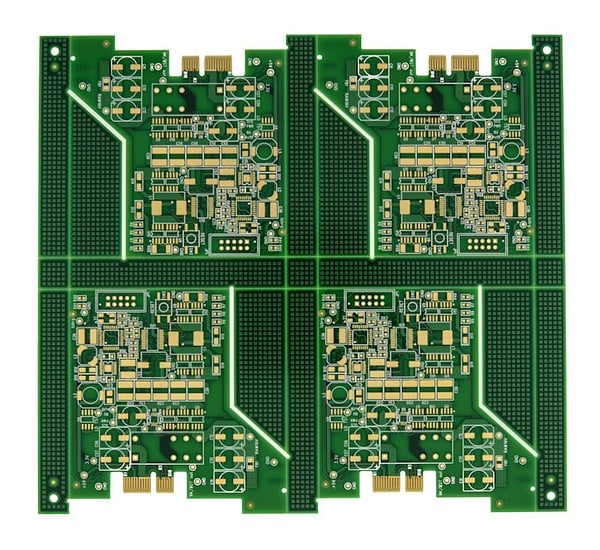The process of v-scoring has been used for many years in the production of printed circuit boards (PCBs). As PCB production technology rapidly advances, it is important to understand the most current PCB scoring guidelines to follow and how they may have changed from what you previously used.
The scoring process consists of two blades rotating, point-to-point, closely together as the PCB moves between the blades. The process almost appears similar a pizza cutter slicing through pizza, moving quickly and allowing the product to move swiftly to the next process, which can in turn improve overall yield. So when should scoring be used on your PCBs and what are some of the potential drawbacks this process?
Squared Printed Circuit Board
Whether your printed circuit board is square or rectangular, all sides have straight lines, and it is clear to cut on the v-score machine. The question to ask is does that make it perfect for scoring or are there other areas to address? To score or not to score? Below are several reasons to say no.
Scoring Thinner PCBs
Printed circuit boards thinner than 0.040" become difficult to score for several reasons. In order to hold a v-score web, a minimum of 0.012" is needed as left behind material (the web) score blades are set to score simultaneously at 0.010" - 0.012" deep from both sides will leave a web of 0.020" +/- 0.004" less than 0.040".
The thinner printed circuit board has some flex in material alone. A pliable PCB using scoring to break method can leave behind rough edges and hanging fibers. Controlling the score process using thinner materials and allowing for a clear break is more difficult. The blades' tolerance setting for depth of the score from the top side and the bottom side is critical, there is a tighter window of accuracy to maintain a web that will not break in assembly. When the score is not balanced in depth from side to side the part will be more difficult to break, leaving behind fibers and possible fracturing edges.
Scoring PCBs in an Array
The more score lines applied, the weaker the array panel can become, allowing for fragile handling, broken arrays, and/or assembly issues.
 Odd Shaped Circuit Board Scored in Array
Odd Shaped Circuit Board Scored in Array
Scoring Smaller Size Parts
The smaller the square inch of a circuit board, the more difficult it is to break. Circuit boards upwards of 0.062" thick are more difficult to break apart when the PCB is small in size. Less than 1 inch in any direction may require additional tools to separate the parts.
Scoring Excessively Long PCBs
Printed circuit boards, boards with a longer X or Y (12 inches or longer), can be weakened and easily broken when scored too deep. Adding heavy components to an already weak array can cause the panel to break during handling, assembly, or even in transit. Implementing jump scores or tab routing may be a better option.
Scoring Thick PCBs
If you are scoring PCBs thicker than 0.096" then the same scenario applies, two blades cutting deeper into the laminate surface leaving behind a web 0.020" +/- 0.004". Beyond this thickness it is tougher to break because there is not enough flex in the material to pop the remaining web leaving behind fibers and an uneven torn look. Using a thicker blade allows for thicker circuit boards to be processed with this method but sometimes causing issues with copper to edge spacing allowances.
Scoring Tools
There are tools available to assist in depanelization of a PCB. However, proper use and monitoring for accuracy is a must to prevent damage of the edges, fracturing or surface scratches. Extra handling of a completely assembled PCB is always a risk.
Adding an Angle or Radius to Your Part
Does this prevent the ability to use the score method?
No, but you will still need flat straight edges to use to score the circuit board. Typically when using the score method, PCBs are butted against each other. The score blades cut from the top and bottom at the same time.
To rout an angle or radius you must leave space between the PCBs. A typical router uses a 0.096" cutter, a minimum of 0.100" is needed to rout cleanly between the parts. Wasted materials between parts also have minimums. A 0.100" between circuit boards is not recommended for spacing and the score method, it is too difficult if not impossible to break, even with tools. When space is needed, scoring is required using 0.200" or greater is recommended.
Rules of PCB Design for the Designer
To answer a common question; yes, you can score just about any printed circuit board that has straight edges but may need to use a combination of scoring and routing.
Higher temperature laminate materials above 150tg have a denser material and weave. Don’t use the standard score parameters that are used in standards for 130tg materials. A deeper score is needed to break this stronger woven material with ease. For higher temperature material use a web of 0.015" +/- 0.004".
Metal from the edge, the keep out should be tailored to the printed circuit board thickness. When at 0.062" or less, keep metal at a minimum of 0.015" from the actual edge of the board. This is a good reference number. Thicker circuit boards are upwards of 0.096" or 0.125" use 0.020" or greater when room allows for all features from the edge of the card.
For printed circuit boards less than 0.040" thickness, always plan for routing using tabs only to avoid any issues.
Summary
If you still have doubts about how to best score your printed circuit board, don’t hesitate to consult your PCB layout engineer. If you don’t have this resource available at your company, we would be glad to have our engineering team help you determine the best solution for your needs. Our free DFM service is always available and we will be happy to make suggestions for panel layout and what you should do next.
PCB Manufacturing Explained: The V-Score & Jump Scoring Process
Key Takeaways
- V-scoring works best for boards with straight edges and adequate thickness: Standard scoring requires a minimum board thickness of 0.040" and leaves a web of about 0.020" ± 0.004". Thinner boards are more prone to rough edges and breakage.
- PCB size, shape, and array design influence score effectiveness: Small boards (under 1 inch), long boards (12 inches or more), and odd-shaped PCBs may require a combination of scoring and routing for clean separation.
- Material type affects scoring depth: High-Tg laminates above 150°C require deeper scoring than standard 130°C materials to ensure a clean break due to their denser weave.
- Metal-to-edge clearance is critical: Maintain at least 0.015" clearance for boards 0.062" thick or less, and 0.020" or more for thicker PCBs to prevent damage during scoring and depanelization.
- Consider routing for very thin boards and complex designs: Circuit boards under 0.040" or with radii and angles often need routing with adequate spacing (0.200" recommended between parts) instead of or in combination with scoring.

















